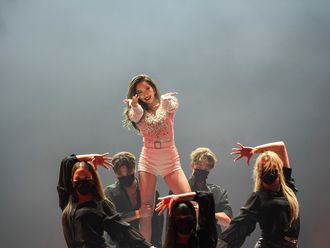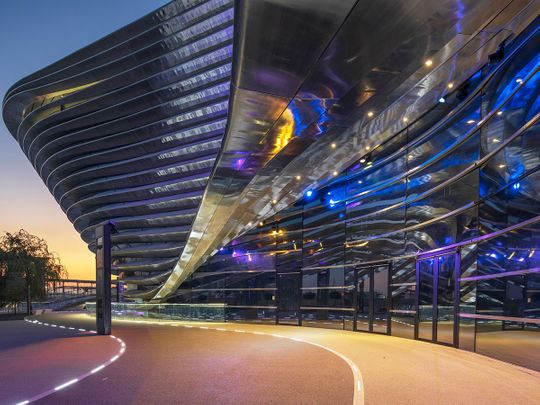
Dubai: Alif – the Mobility Pavilion at Expo 2020 Dubai - is the largest among the three signature pavilions (the other two being Sustainability and Opportunity) at the giant venue.
The pavilion, with 4,368 square metres of event space, was a well-kept secret up until it opened its gates to the world on October 1. Inspired by the infinity loop, the pavilion is the collective efforts of many – including Immersive, a multinational corporation that designed the visual content and spatial storytelling in two out of three wings of the Thematic Pavilion.
The Mobility Pavilion, designed by the award-winning Foster + Partners, features the world’s largest passenger lift, which will transport more than 160 people at a time. The pavilion also features a partly underground, partly open-air 330m track to demonstrate cutting-edge mobility devices in action.
“We worked with MET studio and Emaar on the Mobility Pavilion for three years before bringing Expo 2020 Dubai’s vision of ‘mobility’ to life,” said 37-year-old UK-based Tommy Lexen, Managing Director and Executive Creative Director of Immersive, in an interview with Gulf News.
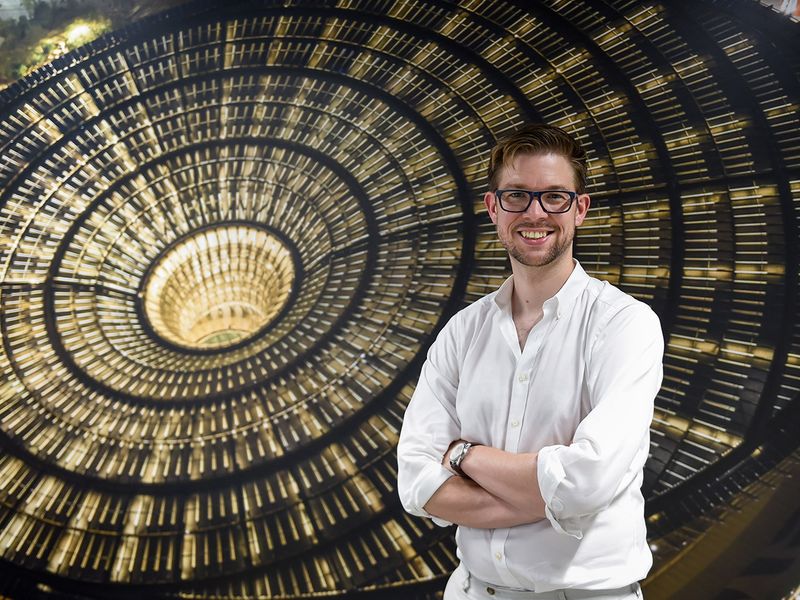
However, this was not the first time Immersive has participated in a World Expo. “We’ve worked for World Expos before, especially in Milan 2015, where we were part of an AI-powered installation gate at the site. However, this is the first time we’re doing a project that scales this big. The experience has been amazing,” Lexen added.
“The mobility of the present and the future is a constantly evolving opportunity to visualise something that people don’t really know, and what we have been working on is to bring in people from all over the spectrum of disciplines, futurists, specialist, CGI, and everything else to come to realise something very different. The third act in mobility, for instance, reimagining the cities of the future through the eyes of a child other than the more sci-fi outlet we used to see.”
A sustainable future fuelled by AI
Step into the pavilion designed by award-winning architecture firm Foster + Partners, and you will watch the future unfold – not the kind you would watch in movies, but from a child’s point of view. “The different themes of Expo 2020 Dubai really resonate to the future of smart cities, especially since they are looking at something broader in terms of how can it be more sustainable, how can you make it autonomous, how can you make it a city that really caters to its residents, business and family interests, all intertwined into one,” said Lexen.
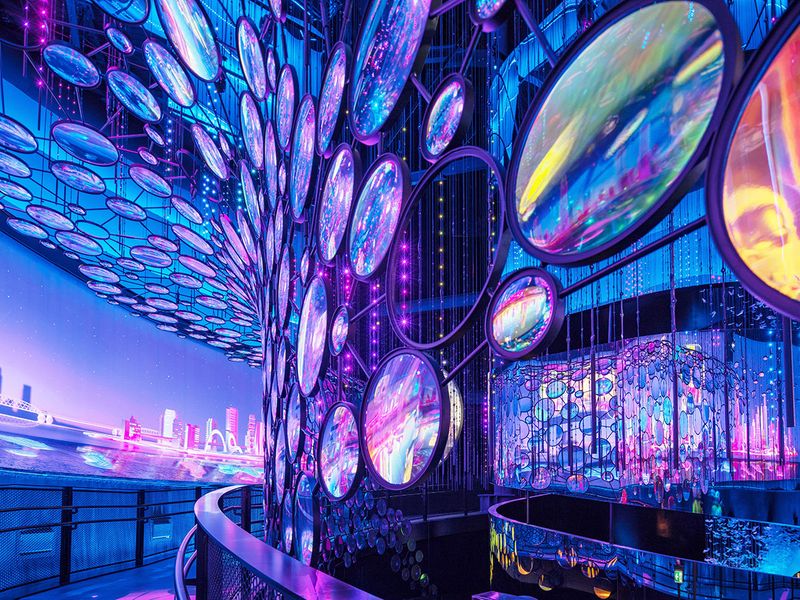
“The focus that we have here is, of course, Nature – especially since there’s plenty of focus on the narrative. Of course, we also see the advent of virtual technologies to communicate across continents, especially through AI, which has influenced our tasks and many of the other technologies we are starting to see on the surface now.
“There are plenty of things to look out for at the Mobility pavilion. One of my personal favourites is the ‘Mobility in the present’ act, from a digital perspective. It is a deconstructed screen installation with over 150 different screens – all of them having individual content, there is no duplications – and the whole of that canvas creates over 227.7 million pixels, which is also the highest number of pixels we have created so far. It’s an extremely exciting canvas to show content for.”
The two ‘acts’
Focused on ‘mobility of the present’ and ‘mobility of the future’, the pavilion features two immersive experiences made from a series of holograms, virtual realities, and more, enabling them to use three out of five senses to their benefit.
“Act 2 is very much about mobility in the present – the journey with the physical mobility and of how, kind of, UAE also are the centre of mobility across the world. It really tails in with the notion of Expo 2020 Dubai, part of which is ‘connecting minds’. So, we start with physical mobility, which is a massive 11-metre globe, where we see global mobility. On the other surface of that is the deconstructed screen surface which I told about earlier, with 150 screens, talking about digital mobility, AI, internet on demand, virtual reality and all the other technologies which we are currently, really exploring throughout the globe,” Lexen said.
“There’s also a ribbon of infographics telling them more of a narrative story of where mobility is specifically focused on the UAE region. The third act features a 23-metre curved screen which you can’t see on a small screen. We had to explore a lot on how to immerse ourselves in it. We were focused on not making AI work for us, but with us,” said Lexen.
Act 3 is a testament to the future – how will our cities look, feel and function, which allow visitors to experience the year 2071.
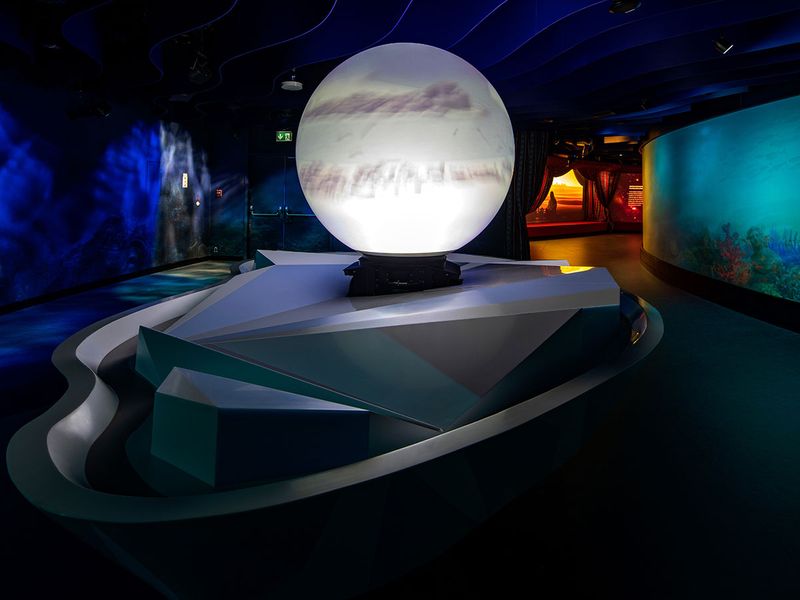
Working through the pandemic
With the pandemic, the world came to a pause. However, for Lexen and his team of creatives, they were already prepared, especially since the execution of the two wings of the Mobility Pavilion at Expo 2020 was based on several collaborations.
“We were working with a very unique team – all of whom were located in various parts of the world – in our offices at London, Shanghai, Toronto and Cape Town. It was a massive collaboration, not just for us, but for our key partners here, the interior designers, especially since they helped us create greenscreen environments and so on. We definitely had a hundred members working on this hands-on, by contributing thousands of hours to execute this one vision in two acts. And now we’re ready to share it with the world,” he said.
“The pandemic was the ultimate challenge, but the really interesting thing is that for us, we were already set up to deliver an agile work flow like this. We build the world inside Virtual Reality, to walk into the environment and test it out. But I think the actual challenge was visualising the future, especially because no one knows what the future is, and there’s plenty of sci-fi and tech involved.”
A world inspired by video games
Lexen said: “So, for us, it was to really find a new way to look at this future and like I said, we as a collective group, came up with the idea to reimagine it from a child’s eye. We had a lot of inspiration from games like Warcraft, Fortnite and we started building it with holograms, AI, and more with people across the world.
“The second challenge was that we weren’t able to come on-site, so we had to deploy a big team of animators, directors and producers for the last few weeks of the project. We had a local team over here from our partners and the rest of us were on screens. And, it worked really well, so that was a highlight.”







